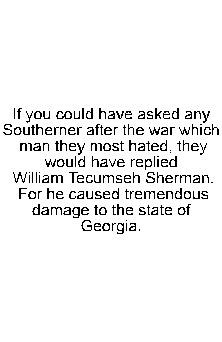|
Email: [email protected] |
|
Sherman's March: Sherman's famous march began on November 15, when he and his army left Atlanta in flames and headed towards Savannah. His sixty thousand men travelled across Georgia virtually unopposed, destroying civilian property and laying waste to anything that might enable the South to continue the war. Sherman's army swept across the state on a ninety-seven kilometre front, stripping houses, barns and fields. They demolished anything that was of no use to them. They tore up railroad tracks and constructed bonfires with the sleepers. Then they heated up the rails until they were - and wound them around trees to make "Sherman's Hairpins." Sherman himself guessed that his men were responsible for over $100 000 000 worth of damage in Georgia alone. He prayed that this terrible destruction would crack the Confederate resolve to fight. Sherman overran Savannah with little opposition on December 21, and sent a letter to Lincoln, "General Sherman makes the American people a Christmas present of the city of Savannah with 150 heavy guns and 25,000 bales of cotton." (P492) From Savannah, the army first marched into South Carolina and then into North Carolina, burning and plundering as they went. A small Confederate force commanded by Johnston made a desperate but futile attempt to stop Sherman in his drive northward to Virginia. |
|
The Atlanta Campaign Cont. |
|
To contact me: |




